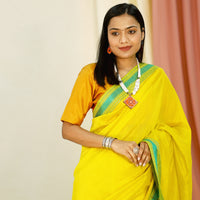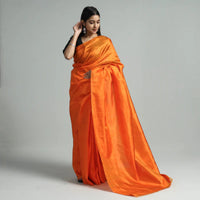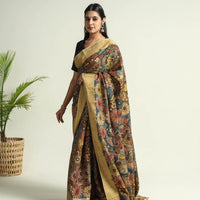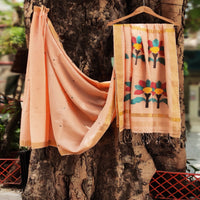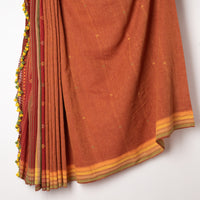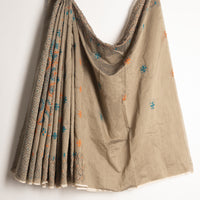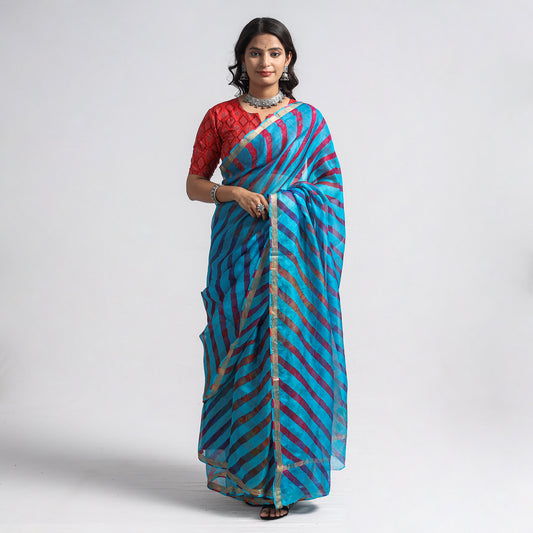The Timeless Craftsmanship of Leheriya Sarees:
Leheriya sarees are a quintessential representation of Rajasthan’s vibrant culture and artistic heritage. This traditional tie-dye technique, which creates stunning wave-like patterns on fabric, has been practiced for centuries in Rajasthan. The word “Leheriya” is derived from the Hindi word “leher,” meaning wave, perfectly capturing the dynamic, flowing patterns that make these sarees so distinctive. Worn by women across India and admired globally, Leheriya sarees are more than just garments; they are a celebration of color, culture, and craftsmanship.
The Art of Making Leheriya Sarees:
Creating a Leheriya saree is an intricate and time-consuming process that requires significant expertise. The process begins with selecting the fabric, which could be cotton, silk, chiffon, or georgette, depending on the desired outcome. Once the fabric is chosen, it is washed thoroughly to remove any impurities and then dried.
The Tying Process:
The magic of Leheriya lies in its unique tying technique. The fabric is rolled diagonally from one corner to the opposite edge, creating a long, narrow bundle. This bundle is then tightly twisted and tied at regular intervals with thread. The tying process is crucial, as it determines the final pattern of the saree. The areas where the fabric is tied will resist the dye, resulting in the characteristic wave patterns once the saree is dyed and untied.
Dyeing:
After the fabric is tied, it is dipped into a dye bath. Traditionally, natural dyes are used, but modern Leheriya sarees may also use synthetic dyes for brighter, more varied color palettes. The fabric is dyed in a single color, but for more complex designs, it can be dyed multiple times in different colors. After each dyeing process, the fabric is untwisted, revealing the vibrant patterns formed by the resist-dye technique. The process may be repeated several times, with the fabric being re-tied and re-dyed, to create multicolored designs with overlapping wave patterns.
Finishing Touches:
Once the dyeing process is complete, the fabric is untied and washed to remove excess dye. It is then dried and ironed, revealing the final Leheriya pattern in all its glory. The finished saree showcases a stunning array of diagonal stripes or waves, each one unique due to the manual process involved in its creation.
Types of Leheriya Sarees:
Leheriya sarees come in a variety of types, each offering a different texture, drape, and appeal. At iTokri, we curate a diverse collection of Leheriya sarees to cater to different tastes and occasions:
1. Cotton Leheriya Sarees:
• Description: These sarees are made from soft, breathable cotton, making them ideal for everyday wear, especially in warmer climates. The lightweight fabric combined with the vibrant Leheriya patterns makes these sarees both comfortable and stylish.
• Ideal For: Casual outings, day-to-day wear, and festive occasions.
2. Silk Leheriya Sarees:
• Description: Silk Leheriya sarees exude luxury and elegance. The smooth, rich texture of silk enhances the beauty of the wave patterns, making these sarees perfect for special occasions.
• Ideal For: Weddings, festive celebrations, and formal events.
3. Georgette Leheriya Sarees:
• Description: Georgette is a lightweight, slightly sheer fabric that drapes beautifully, making it a popular choice for Leheriya sarees. The fluidity of georgette, paired with the dynamic Leheriya patterns, creates a saree that is both graceful and eye-catching.
• Ideal For: Semi-formal events, parties, and casual occasions.
4. Chiffon Leheriya Sarees:
• Description: Chiffon Leheriya sarees are known for their light, airy feel, making them perfect for those who prefer a saree that is easy to manage and carry. The delicate texture of chiffon, paired with the vibrant Leheriya patterns, makes these sarees ideal for both casual and semi-formal occasions.
• Ideal For: Casual outings, evening wear, and lightweight draping.
Colors and Patterns in Leheriya Sarees:
Leheriya sarees are celebrated for their bold, vibrant colors and the fluidity of their patterns. The colors used in Leheriya sarees are typically bright and contrasting, reflecting the lively spirit of Rajasthan. Traditional Leheriya sarees often feature combinations like red and yellow, blue and green, or pink and orange, creating a visually striking effect. The wave patterns are created through the resist-dye technique, with each color adding a layer of complexity to the design.
The patterns in Leheriya sarees can range from simple, diagonal stripes to more intricate designs with multiple overlapping waves or additional motifs. The multicolored Leheriya sarees, where the fabric is dyed in more than one color, are particularly popular for festive occasions. The use of natural dyes in traditional Leheriya sarees adds to their charm, as these colors tend to mellow and gain character over time, enhancing the saree’s beauty.
Regional Origin and Communities Practicing Leheriya:
Leheriya sarees are deeply rooted in the cultural traditions of Rajasthan, a state known for its rich heritage of textile crafts. The art of Leheriya is predominantly practiced in the cities of Jaipur, Jodhpur, and Udaipur, where it has been passed down through generations of artisans. The Marwari community in Rajasthan is especially known for their mastery of this craft.
Historically, Leheriya sarees were worn by Rajasthani women during the monsoon season, symbolizing the arrival of rain and the rejuvenation of the earth. The wave patterns in Leheriya sarees represent the flowing water of the monsoons, making them an integral part of Rajasthani festive wear. The craft of Leheriya has been kept alive by the skilled artisans of Rajasthan, who continue to produce these sarees using traditional methods, ensuring that each piece is a true work of art.
Cultural Significance and Modern Appeal:
Leheriya sarees are not just traditional garments; they have a timeless appeal that has been embraced by women across India and around the world. The bright colors and dynamic patterns make Leheriya sarees a popular choice for celebrations, where they are often paired with traditional jewelry and accessories. The simplicity of the design, combined with the complexity of the dyeing process, gives Leheriya sarees a unique charm that is both elegant and versatile.
In modern times, Leheriya sarees have found their place in contemporary fashion as well. Designers have experimented with the traditional patterns, introducing new color combinations and fabrics, while still maintaining the essence of the Leheriya craft. Whether worn for a traditional festival or a modern-day party, Leheriya sarees offer a perfect blend of tradition and style.
Why Choose Leheriya Sarees from iTokri?
At iTokri, we are committed to bringing you the finest selection of authentic Leheriya sarees, sourced directly from the skilled artisans of Rajasthan. Our collection reflects the diversity of this traditional craft, offering a range of fabrics, colors, and patterns to suit every occasion. By choosing a Leheriya saree from iTokri, you are not just buying a beautiful piece of clothing; you are supporting the artisans who continue to keep this vibrant craft alive.
Each Leheriya saree in our collection is crafted with care and attention to detail, ensuring that you receive a garment that is both beautiful and of the highest quality. Whether you are looking for a cotton Leheriya saree for everyday wear or a luxurious silk Leheriya saree for a special occasion, iTokri has something to suit your needs.
Explore our stunning collection of Leheriya sarees today and bring a piece of Rajasthan’s vibrant culture into your wardrobe. With a wide range of options available, including cotton Leheriya sarees, Leheriya silk sarees, and georgette Leheriya sarees, you’re sure to find the perfect saree for any occasion. Shop Leheriya sarees online at iTokri and experience the beauty and elegance of this timeless craft.
FAQ Section:
1. What is a Leheriya saree?
• A Leheriya saree is a traditional Indian saree from Rajasthan, characterized by its unique wave-like patterns created through a tie-dye technique. The word “Leheriya” comes from “leher,” meaning wave, which perfectly describes the dynamic, flowing designs on these sarees. Leheriya sarees are known for their vibrant colors and are often worn during festivals and special occasions.
2. How are Leheriya sarees made?
• The making of a Leheriya saree involves several steps:
1. Fabric Selection: The process starts with selecting a fabric, typically cotton, silk, chiffon, or georgette.
2. Tying: The fabric is rolled diagonally and tightly twisted, then tied at regular intervals with thread to create resist points that will not absorb the dye.
3. Dyeing: The tied fabric is dipped into a dye bath. After dyeing, the fabric is untwisted, revealing the wave patterns. This process may be repeated to add multiple colors.
4. Finishing: The fabric is untied, washed, dried, and ironed to reveal the final Leheriya design.
3. What are the different types of Leheriya sarees available at iTokri?
• iTokri offers a wide variety of Leheriya sarees, including:
• Cotton Leheriya Sarees: Lightweight and breathable, ideal for everyday wear and casual occasions.
• Silk Leheriya Sarees: Luxurious and elegant, perfect for festive occasions and formal events.
• Georgette Leheriya Sarees: Known for their fluid drape and vibrant patterns, ideal for semi-formal events.
• Chiffon Leheriya Sarees: Light and airy, making them perfect for both casual and semi-formal occasions.
4. What colors are commonly used in Leheriya sarees?
• Leheriya sarees are known for their bright, bold colors. Traditional Leheriya sarees often feature color combinations like red and yellow, blue and green, pink and orange, and more. The use of natural dyes in traditional sarees adds to their richness, with colors like indigo, turmeric yellow, and madder red being commonly used. Modern variations may also include pastel shades and contemporary color combinations.
5. What occasions are Leheriya sarees suitable for?
• Leheriya sarees are versatile and can be worn for various occasions:
• Casual Wear: Cotton and chiffon Leheriya sarees are perfect for everyday wear and casual outings.
• Festive Occasions: Silk and georgette Leheriya sarees are ideal for festive celebrations, weddings, and other special events due to their luxurious feel and vibrant designs.
• Religious Ceremonies: The wave patterns and bright colors make them a popular choice for religious ceremonies and rituals.
6. How do I care for my Leheriya saree?
• To maintain the vibrancy and longevity of your Leheriya saree:
• Dry Clean: It is recommended to dry clean the saree, especially if it’s made of silk or georgette, to preserve the colors and fabric.
• Hand Wash: If washing at home, use cold water and a mild detergent. Avoid wringing the fabric, and dry it in the shade to prevent color fading.
• Storage: Store your Leheriya saree in a cool, dry place, preferably wrapped in a muslin cloth, to avoid damage to the fabric and colors.
7. Are Leheriya sarees eco-friendly?
• Yes, traditional Leheriya sarees are eco-friendly. They are often dyed using natural dyes made from plants, roots, and minerals, and the tie-dye process is manual, which minimizes the environmental impact. Additionally, purchasing authentic Leheriya sarees supports the artisans who practice sustainable and traditional methods of textile production.
8. What is the cultural significance of Leheriya sarees?
• Leheriya sarees hold deep cultural significance in Rajasthan. Historically, they were worn during the monsoon season, symbolizing the arrival of rain and the rejuvenation of life. The wave patterns represent the flowing water of the monsoons. Today, they continue to be a symbol of Rajasthani culture, often worn during festivals, religious ceremonies, and weddings.
9. How can I verify the authenticity of a Leheriya saree?
• To ensure that your Leheriya saree is authentic:
• Inspect the Patterns: Authentic Leheriya sarees will have wave-like patterns that are slightly irregular, a hallmark of the manual tying process.
• Check the Fabric: Traditional Leheriya sarees are made from high-quality fabrics like cotton, silk, georgette, or chiffon.
• Feel the Texture: Authentic Leheriya sarees should have a soft, natural feel, especially if they are made from organic or natural fabrics.
• Smell the Fabric: Sarees dyed with natural dyes often have a distinct, earthy smell, which is another indicator of authenticity.
10. Can I find authentic Leheriya sarees online at iTokri?
• Absolutely! iTokri offers a carefully curated collection of authentic Leheriya sarees sourced directly from skilled artisans in Rajasthan. Our sarees are crafted using traditional methods, ensuring you receive a genuine piece of this vibrant craft. Explore our collection online and choose from a variety of fabrics, colors, and designs to find the perfect Leheriya saree for any occasion.
लेहरिया साड़ियाँ राजस्थान की समृद्ध सांस्कृतिक और कलात्मक धरोहर का प्रतीक हैं। इस पारंपरिक टाई-डाई तकनीक से कपड़े पर लहरों जैसी खूबसूरत आकृतियाँ बनाई जाती हैं। “लेहरिया” शब्द हिंदी के “लहर” से लिया गया है, जो इन साड़ियों के गतिशील, प्रवाही पैटर्न को दर्शाता है। लेहरिया साड़ियाँ न केवल भारत में बल्कि विश्वभर में प्रशंसित हैं और रंग, संस्कृति और हस्तशिल्प का उत्सव हैं।
लेहरिया साड़ी बनाने की प्रक्रिया जटिल और समय लेने वाली होती है। इसमें पहले कपड़े का चयन किया जाता है, जो कॉटन, सिल्क, शिफॉन या जॉर्जेट हो सकता है। फिर कपड़े को धुलाई के बाद तिरछी दिशा में मोड़कर बांधा जाता है। इस प्रक्रिया में कपड़े के बांधे गए हिस्से रंग को अवशोषित नहीं करते, जिससे लहरों जैसे पैटर्न उभरते हैं। इसके बाद कपड़े को रंग में डुबोया जाता है और सुखाया जाता है।
लेहरिया साड़ियों में विभिन्न प्रकार के कपड़े और रंग होते हैं, जो इन्हें विभिन्न अवसरों के लिए उपयुक्त बनाते हैं। पारंपरिक लेहरिया साड़ियाँ चमकदार और विपरीत रंगों में बनाई जाती हैं, जैसे लाल-पीला, नीला-हरा, आदि। ये साड़ियाँ मुख्य रूप से जयपुर, जोधपुर और उदयपुर में बनाई जाती हैं और मारवाड़ी समुदाय द्वारा उनकी कला को पीढ़ियों से संरक्षित किया गया है।
iTokri पर, आप लेहरिया साड़ियों का विस्तृत और प्रामाणिक संग्रह पा सकते हैं, जो सीधे राजस्थान के कुशल कारीगरों से प्राप्त किया गया है।












